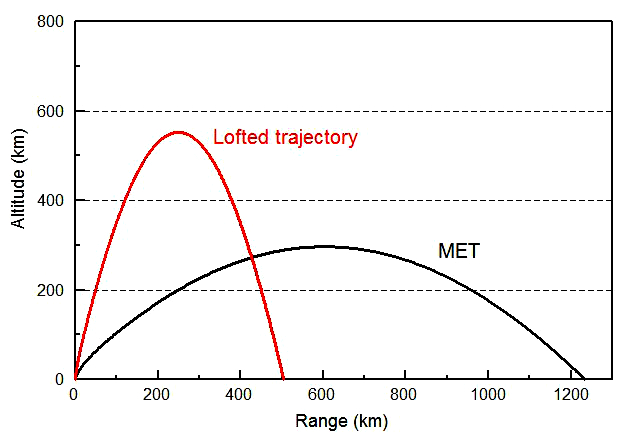Last week, on August 24, North Korea conducted a test of the KN-11 submarine-launched missile it is currently developing. This is the third test of the missile this year, and the first time the missile appeared to operate as planned. (A list of previous tests can be found here.)
The missile appears to use solid fuel rather than liquid fuel like most of North Korea’s missiles, and has two stages.
A key question is what range the KN-11 may have. As I show below, the maximum range of the missile that was tested appears to be about 1,250 km.
Determining the KN-11 range
The KN-11 reportedly flew to a range of 500 km in the recent test. But as Jeffrey Lewis points out in his recent post at armscontrolwonk, photos from the North Korean missile control center contain images of computer screens that show the missile following a lofted trajectory. If it followed a lofted trajectory, its maximum range would be longer than 500 km. The question is how much longer.
Jeffrey’s colleague Dave Schmerler at the Monterey Institute once again was able to provide me with data from high resolution photos showing the Korean computer screens. We were able to determine that the August 24 launch reached a maximum altitude of about 550 km.
Knowing the range and apogee of the test allows us to determine the maximum range of the missile if it was launched on a standard trajectory.
I adjusted the parameters of a computer model of the missile to give a range of 500 km with an apogee of 550 km. Using those same parameters, I then used the computer model to calculate what the maximum range of that missile would be if flown on a non-lofted trajectory.
That calculation gives a range for the KN-11 of about 1,250 km on a standard “minimum-energy” (MET) trajectory, assuming the same payload as the lofted test. The result is shown in Fig. 1.

Fig. 1
This range is similar to North Korea’s Nodong missile, and would allow it reach most or all of Japan from a submarine located near the Korean coast. While theoretically the missile could reach more distant targets if the submarine moved farther from the coast, the submarines are relatively noisy and would likely be sitting ducks for anti-submarine attacks if they strayed too far.
While the missile doesn’t have the range to bring new targets, like Guam, into range, as Jeffrey points out, using the KN-11 as a mobile solid-fuel land-based missile would have the advantage that it would not require the fueling preparation time that the liquid-fuel Nodong does.
